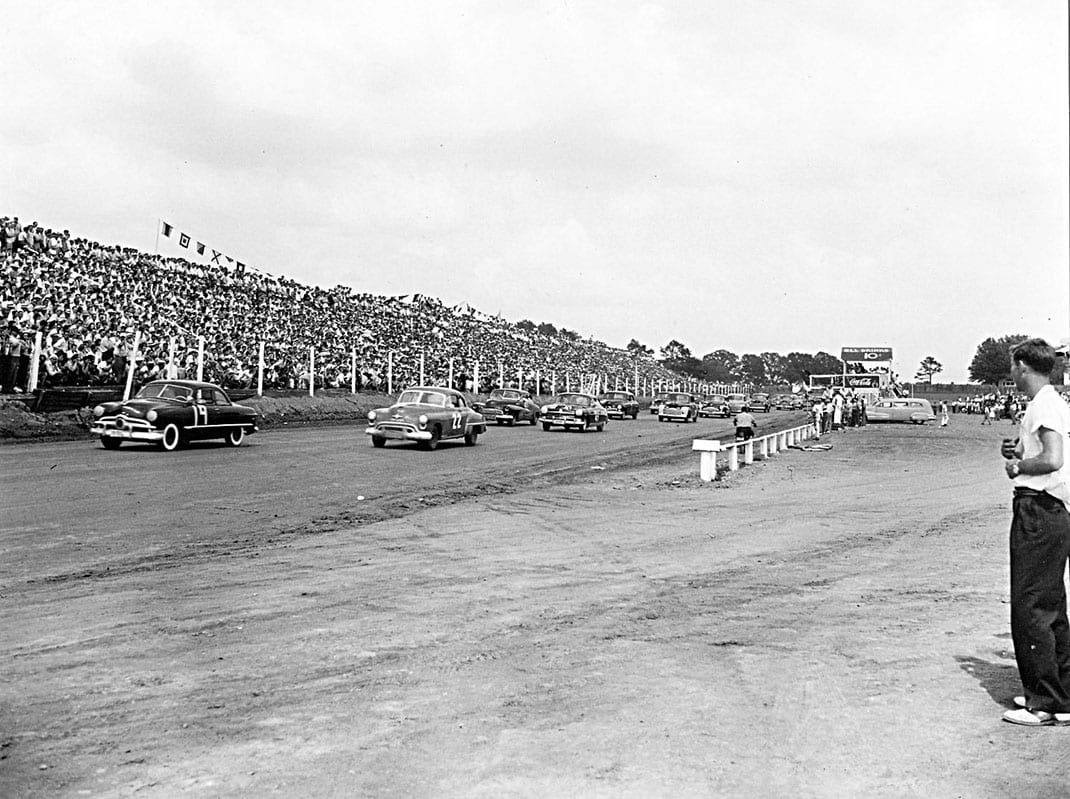This story first appeared in the June 2014 edition of SPEED SPORT Magazine.
A decade before NASCAR was officially incorporated in February of 1948, dirt tracks sprang up throughout the South, some in cow pastures and open fields. By the late 1940s, they had become centers of attraction at local fairgrounds when hastily constructed ovals were often made with the quick sweep of a bulldozer.
Moonshiners drew fans to local dirt tracks in Virginia, North Carolina, Tennessee and Georgia. Those buying tickets often heard the legendary stories of how those brave souls escaped the revenue agents and wanted a glimpse of the fishtails and slides that made them so famous.
Roy Hall, Tim Flock, Junior Johnson and Lloyd Seay to name only a few, were as popular as moonshine runners as they were racers. In the summer of 1945 at the dirt-surfaced Lakewood Speedway in Atlanta, a riot was diverted when the track promoter trying to clean up the sport’s image finally agreed to allow known moonshiners to take their places in the starting lineup. To the delight of the crowd, Hall won the race.
One of the best on dirt tracks was lumberman Curtis Turner, a very popular NASCAR driver who co-founded Charlotte Motor Speedway in 1960. Turner began running moonshine on dirt roads throughout Roanoke County, Va., when he was only 10 years old. He went on to win 55 races including events in NASCAR’s convertible division.
“Curtis could win in anything he sat down in, said 2012 NASCAR Hall of Fame inductee Leonard Wood in the 2013 Hall of Fame program. “That came from the moonshine running back in the 1930s and ’40s.
“I remember we asked him to get in the car one day to see how it would handle. He threw his right leg through the window opening above the driver’s side door and said, ‘it feels just right.’ Curtis was quite a character.”
As many as 40 Cup races per season were held at dirt tracks from 1949 through 1970. In the final year, only three were run on dirt — two on the half-mile at Columbia (S.C.) Speedway and the final stop in Raleigh at a rough one-mile track used for horse racing. Bobby Isaac won one of the Columbia races, while seven-time Cup champion Richard Petty took the other Columbia win. Petty also won at Raleigh on Sept. 30, 1970.
“A lot of times on dirt, the driver makes up more…than he can on asphalt, because the cars run sideways, run into holes and all that stuff,” Petty told NASCAR.com in an article published on July 23, 2013.
“I always felt the driver could make up so much more then,” Petty said. “It was so much fun. On asphalt, they always got one groove, maybe around the middle, maybe outside. But on dirt, you could go anywhere you needed to run fast. You could run outside, in the middle, up against the banking. It was more of a challenge. The fun deal was (racing on) dirt.”
There have been 76 different winners in 490 previous NASCAR races contested on dirt tracks. That figure doesn’t include wins on the beach course used in Daytona Beach, Fla., where the track included both asphalt and sand. Lee Petty, Richard’s father, holds the record for most NASCAR dirt-track wins with 42. Richard had 30 wins of his own.
Dale Inman, Petty’s crew chief for 195 of his 200 career wins, remembers how hectic race schedules on dirt and asphalt could be in the 1960s.
“We would run one night on dirt and a couple of nights later on asphalt. You had to be versatile back then,” Inman said. “There was quite a bit of difference between and dirt track and asphalt track but as a crew chief, you really didn’t have a lot to work with like they have today. You could only change a couple of things. We had a lot of torsion bars in our cars when we ran Chrysler products. We would run a couple of them and maybe a sway bar and a couple of springs to work with and that was about it.”
Click below to keep reading.
